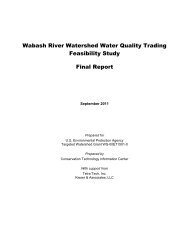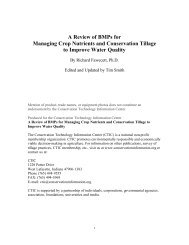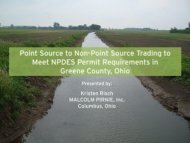Facilitating Conservation Farming Practices and Enhancing ...
Facilitating Conservation Farming Practices and Enhancing ...
Facilitating Conservation Farming Practices and Enhancing ...
You also want an ePaper? Increase the reach of your titles
YUMPU automatically turns print PDFs into web optimized ePapers that Google loves.
18<br />
Biotech<br />
Crops<br />
Reduce<br />
Pesticide<br />
Use<br />
Among the most attractive benefits of many early biotech crops –<br />
from a grower perspective as well as an environmental one – is their<br />
built-in ability to combat pests such as insects or pathogens, or to<br />
allow producers to use highly effective products to fight weeds. The net<br />
result is not just more grower-friendly crops, but also a reduction in the<br />
cost of production <strong>and</strong> the use of crop protection chemicals.<br />
Combating Weeds<br />
Weeds are the leading challenge for soybean growers worldwide,<br />
causing more yield loss than either insects or diseases (Heatherly et<br />
al., 2009; Oerke, 2006). Oerke (2006) estimates global yield loss to<br />
weeds at 37 percent. The development of herbicides in the latter half of<br />
the 20th century replaced time- <strong>and</strong> tillage-intensive mechanical weed<br />
control with management-intensive chemical control.<br />
Herbicides brought challenges of their own. The efficacy of available<br />
herbicides on specific weed species caused shifts in the population<br />
dynamics of weeds, with less-adequately-controlled species increasing<br />
in dominance until other herbicides or mechanical weed control<br />
were introduced. Many persistent soil herbicides, used for decades on<br />
millions of acres of cropl<strong>and</strong> each year, found their way into streams<br />
<strong>and</strong> groundwater.<br />
Targeting, timing <strong>and</strong> application also require knowledge <strong>and</strong> skill.<br />
By 1996, the year glyphosate-tolerant soybeans were introduced to the<br />
marketplace, 27 different herbicidal active ingredients representing<br />
nine distinct modes of action, each with its own strengths <strong>and</strong> weaknesses,<br />
were registered for use in U.S. soybeans (Heatherly et al.,<br />
2009). By contrast, planting Roundup Ready soybeans allowed growers<br />
to apply glyphosate, the active ingredient in Roundup <strong>and</strong> several<br />
other herbicides, as a broadcast post-emergence spray to control a<br />
broad spectrum of weeds in one or two applications.<br />
Glyphosate is a remarkable herbicide, both in its efficacy <strong>and</strong> its<br />
environmental profile. When it comes in contact with plant tissue,<br />
glyphosate translocates quickly through the plant to accumulate in the








